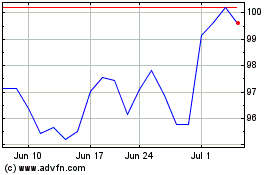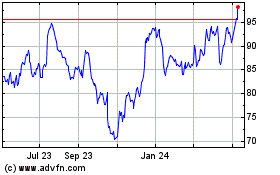Morgan Stanley Books Archegos Loss, but Profit Hits New High -- 2nd Update
April 16 2021 - 11:34AM
Dow Jones News
By Peter Rudegeair
Morgan Stanley lost $911 million when Archegos Capital
Management imploded last month, tarnishing a record-setting quarter
for the Wall Street firm.
The New York-based bank on Friday reported quarterly profit of
$4.1 billion, or $2.19 a share, on revenue of $15.7 billion. That
beat the consensus estimates of analysts polled by FactSet of
per-share earnings of $1.72 on revenue of $14.1 billion.
Morgan Stanley reaped big gains from the euphoric market
conditions of early 2021. But record performance across many of the
bank's businesses was offset by credit and trading losses it booked
following a fire sale of more than $30 billion worth of stocks tied
to Archegos, the family office run by former Tiger Asia manager
Bill Hwang.
More than two-thirds of the banks' losses on Archegos were
related to collateral Morgan Stanley sold at lower prices to repay
margin loans the fund borrowed to increase its holdings in a small
number of stocks. The remainder of the Archegos losses came when
the bank closed out smaller Archegos positions that it hadn't
seized to meet the margin call, Chief Executive James Gorman said
on a conference call with analysts.
While those positions weren't especially problematic for the
bank, Mr. Gorman said, it chose not to take the risk that they
could later sour and lead to bigger losses. "I regard that decision
as necessary and money well spent," he said. "We didn't want this
thing to be lingering."
Morgan Stanley's obligations to an investment-banking client
prevented it from acting sooner to avoid losses, Mr. Gorman added.
During the last week of March, the bank had a lead role arranging a
sale of stock for ViacomCBS Inc., a company in which Archegos held
a large stake. Morgan Stanley waited until that offering closed
before it liquidated Archegos's holdings of ViacomCBS, ceding
first-mover advantage to Archegos's other lenders.
Mr. Gorman said Morgan Stanley will take a hard look at its
relationships with family offices such as Archegos that have
concentrated positions across multiple banks. "We're never happy
taking a loss, but our job is to deal with the facts as reality and
get on top of it," he said.
Still, Morgan Stanley rounded out an all-time great first
quarter from the nation's big banks. Asset prices rallied, millions
of investors traded stocks with abandon and scores of technology
and special-purpose acquisition companies listed their shares
publicly, creating an optimal environment for banks' Wall Street
divisions. On Wednesday, Morgan Stanley rival Goldman Sachs Group
Inc. reported record quarterly revenue and net income.
The same waves that lifted Goldman also lifted Morgan Stanley.
Stock- and bond-trading revenue rose 29% to $5.8 billion. Fees from
advising on deals and underwriting stock and bond offerings more
than doubled to $2.6 billion.
Morgan Stanley's E*Trade business also benefited from the burst
of trading activity among individual investors. The number of
retail-trading clients at Morgan Stanley increased 7% from the end
of 2020 to 7.2 million, and the average daily number of retail
trades the company handled for the quarter exceeded 1.6
million.
Revenue at Morgan Stanley's wealth-management division, which
includes E*Trade, increased 47% to roughly $6 billion. Its profit
margin reached 27% before taxes, up slightly from the first quarter
of 2020.
The firm's return on tangible equity, a measure of how
profitably it puts shareholders' money to use, was 21% for the
quarter.
Operating expenses increased 45% to $10.5 billion thanks in part
to a 59% increase in compensation and benefits. Morgan Stanley's
first-quarter compensation expense of $6.8 billion was 43% of
revenue, a similar ratio from a year earlier.
Unlike other banks that have reported weak demand for loans
among their consumer and commercial clients, Morgan Stanley boosted
lending by 15% to $303.4 billion outstanding.
Write to Peter Rudegeair at Peter.Rudegeair@wsj.com
(END) Dow Jones Newswires
April 16, 2021 11:19 ET (15:19 GMT)
Copyright (c) 2021 Dow Jones & Company, Inc.
Morgan Stanley (NYSE:MS)
Historical Stock Chart
From Mar 2024 to Apr 2024

Morgan Stanley (NYSE:MS)
Historical Stock Chart
From Apr 2023 to Apr 2024
